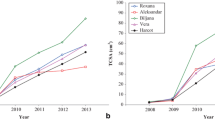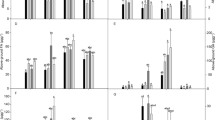Abstract
Leafy vegetables are important for food security and human health and nutrition. However, their growth, development and yield are often affected by weeds. Therefore, we investigated the growth performance and ferulic acid composition of Amaranthus species and Mitracarpus villosus in competition with local weed species by measuring growth and productivity rate, morphological anomalies, chlorophyll content, acid exudation by roots, and ferulic acid content, Results suggest that weed competition had negative effects on Amaranthus and Mitracarpus with an inverse relationship in most of the parameters assessed. Amaranthus hybridus in the weeded plot had a plant height of 13.30 cm after 6 weeks whereas it was 11.50 cm in the unweeded plot. After 6 weeks, the leaf area index of Mitracarpus villosus was 5.40 cm2 and 4.80 cm2 in the weeded and unweeded plots, compared to Amaranthus viridis in both the weeded and unweeded plots, which were 12.90 cm2 and 6.20 cm2 respectively. Ferulic acid content in M. villosus was 33.9 µg/ml in the unweeded plot and 64.27 µg/ml in the weeded plot. Weed competition had greater effects on growth parameters than ferulic acid. Overall, weed competition has species-specific effects on the two vegetable species and also depends on the density, diversity and richness of weed species.










Similar content being viewed by others
References
Abdollahian M, Froud-Williams RJ (2005) Above and below ground competition of Chenopodium album and sugar beet. Iran J Weed Sci 1:5–18
Adeux G, Vieren E, Carlesi S, Barberi P, Munier-Jolain N, Cordeus S (2019) Mitigating crop yield losses through weed diversity. Nat Sustain 2:1018–1026
Al-Chalabi FT, Al-Agidi HSM (2010) Competitive ability if some wheat cultivars to accompanied weeds and its impact on yield and yield component. Anbar J Agric Sci 8(4):352–362
Almaghrabi OA (2012) Control of wild oat (Avena fatua) using phenolic compounds I—germination and some growth parameters. Saudi J Biol Sci 19:17–24
Anantharaju PG, Gowda PC, Vimalambike MG, Madhunapantula SV (2016) An overview on the role of dietary phenolics for the treatment of cancers. Nutr J 15(1):99
Andrew IKS, Storkey J, Sparkes DL (2015) A review of the potential for competitive cereal cultivars as a tool in integrated weed management. Weed Res 55(3):239–248
Arab F, Alemzadeh I, Maghsoudi V (2011) Determination of antioxidant component and activity of rice bran extract. Sci Iran 18(6):1402–1406
Baghestani MA, Zand E, Soufizadeh S, Eskandari A, PourAzar R, Veysi M, Nassirzadeh N (2006) Efficacy evaluation of some dual purpose herbicides to control Weeds in Maize (Zea mays L.). Crop Prot 26:936–942
Bezerra G, Pereira M, Ostrosky E, Barbosa E, Moura M, Ferrari M, Aragão C, Gomes A (2017) Compatibility study between ferulic acid and excipients used in cosmetic formulations by TG/DTG, DSC and FTIR. J Therm Anal Calorim 127:1683–1691
Boopathi MP (2010) Challenges in Weed Management in Agro-Ecosystems: present status and future strategies, Conference, Coimbatore, 8 December 2010
Bukun B (2011) Influence of redroot pigweed (Amaranthus retroflexus) density and biomass on peanus (Arachis hypogaea) yield. Afr J Biotech 104(4):19542–19546
Bunzel M, Ralph J, Steinhart H (2005) Association of non-starch polysaccharides and ferulic acid in grain amaranth (Amaranthus caudatus L.) dietary fiber. Mol Nutr Food Res. 49(6):551–559
Caton BP, Cope AE, Mortimer M (2003) Growth traits of diverse rice cultivars under competition: implications for screening for competitiveness. Field Crop Res 80:157–172
Carvalho MSS, Andrade-Vieira LF, Santos FE, Correa FF, Cardoso MG, Vilela LR (2019) Allelopathic potential and phytochemical screening of ethanolic extracts from five species of Amaranthus spp. in the plant model Lactuca sativa. Sci Hortic 245:90–98
Colbach N, Gardarin A, Moreau D (2019) The response of weed and crop species to shading: whichparameters explain weed impacts on crop production? Field Crops Res 238:45–55. https://doi.org/10.1016/j.fcr.2019.04.008
Gaba S, Perronne R, Fried G, Gardarin A, Bretagnolle F, Biju-Duval L, Colbach N, Cordeau S, Fernandez-Aparicio M, Gauvrit C, Gibot-Leclerc S, Guillemin J-P, Moreau D, Munier-Jolain N, Strbik F, Reboud X (2017) Response and effect traits of arable weeds in agro-ecosystems: a review of current knowledge. Weed Res 57(3):123–147
Gao J, Yu H, Guo W, Kong Y, Gu L, Li Q, Yang S, Zhang Y, Wang Y (2018) The anticancer effects of ferulic acid is associated with induction of cell cycle arrest and autophagy in cervical cancer cells. Cancer Cell Int 18:102
Gul K, Yousuf B, Singh AK, Singh P, Wani AA (2015) Rice bran: Nutritional values and its emerging potential for development of functional food—a review. Bioact Carbohydr Diet Fibre 6(1):24–30
Gunathilake K, Ranaweera K, Rupasinghe H (2018) In vitro anti-inflammatory properties of selected green leafy vegetables. Biomedicines 6(4):107
Habib SA, Alshamma AM (2002) Competitive potential of six wheat varieties with broadleaf weeds in central plains of Iraq. IJAS 7(5):157–163
Hakim MdA, Juraimi AS, Musa MH, Ismail MR, Rahman MMd, Selamat A (2013) Impacts of weed competition on plant characters and the critical period of weed control in rice under saline environment. Aust Crop Sci 7(8):1141–1151
Hammood WF, Safi SM (2018) Effect of weed competition in the characteristics of growth and yield and its components of wheat crop Triticum aestivum L.: a mini review. J Res Ecol 6(1):1637–1646
Hornick BA, Weiss L (2011) Comparative nutrient analysis of commonly consumed vegetables. Nutr Today 46:130–137
Hasanuzzaman M (2015) Crop-weed competition. Available online: https://hasanuzzaman.weebly.com/uploads/9/3/4/0/934025/cropweed_competetion.pdf. Accessed 15 Dec 2018
Imoloame EO, Omolaiye JO (2017) Weed infestation, growth and yield of Maize (Zea mays L.) as Influenced by Periods of Weed Interference. Adv Crop Sci Tech 5:267. https://doi.org/10.4172/2329-8863.1000267
Iqbal E, Kamariah AS, Linda BLL (2015) Phytochemical screening, total phenolics and antioxidant activities of bark and leaf extract of Goniothalamus velutinus (Air Shaw) from Brunei Darussalam. J King Saud Univ Sci 2(3):224–232
Karkanis A, Ntatsi G, Alemardan A, Petropoulos S, Bilalis D (2018) Interference of weeds in vegetable crop cultivation, in the changing climate of Southern Europe with emphasis on drought and elevated temperatures: a review. J Agric Sci 156(10):1175–1185. https://doi.org/10.1017/S0021859619000108
Khan FA, Din JU, Ghaffoor A, Khan KW (2002) Evaluation of different cultivars of okra (Abelmoschus esculentus L.) under the Agroclimatic conditions of Dera Ismail Khan. Asian J Plant Sci 1(6):663–664
Kruepl C, Hoad S, Davies K, Bertholdsson N-O, Paolini R (2007) Weed competitiveness. In: Donna D, Osman A (eds) Susvar handbook cereal variety testing for organic low input agriculture. COST860-SUSVAR. Risø National Laboratory, Denmark, pp W1–W16
Kumari S, Elancheran R, Devi R (2018) Phytochemical screening, antioxidant, anti-tyrosinase, and antigenotoxic potential of Amaranthus viridis extract. Indian J Pharmacol 50:130–138
Levitt J (1980) Responses of plant to environmental stresses, 2nd edn. Academic Press, New York
Li ZH, Wang Q, Ruan X, Pan CD, Jiang DA (2010) Phenolics and plant allelopathy. Molecules 15(12):8933–8952. https://doi.org/10.3390/molecules15128933
Ma X, Wu H, Jiang W, Ma Y, Ma Y (2015) Interference between Redroot Pigweed (Amaranthus retroflexus L.) and Cotton (Gossypium hirsutum L.): Growth Analysis. PLoS One 10(6):e0130475. https://doi.org/10.1371/journal.pone.0130475
Nagendra PMN, Sanjay KR, Shravya KM, Vismaya MN, Nanjunda SS (2011) Health benefits of rice bran—a review. J Nutr Food Sci 1(3):1–7
Ogwu MC, Osawaru ME, Aiwansoba RO, Iroh RN (2016) Status and prospects of vegetables in Africa. In: Borokini IT, Babalola FD (eds) Conference proceedings of the joint biodiversity conservation conference of Nigeria Tropical Biology Association and Nigeria chapter of society for conservation biology on MDGs to SDGs: toward sustainable biodiversity conservation in Nigeria. University of Ilorin, Nigeria, pp 47–57
Ogwu MC (2019) Towards sustainable development in Africa: the challenge of urbanization and climate change adaptation. In: Cobbinah PB, Addaney M (eds) The geography of climate change adaptation in Urban Africa. Springer Nature, Switzerland, pp 29–55
Ogwu MC (2020) Value of Amaranthus [L.] species in Nigeria. In: Waisundara V (ed) Nutritional value of Amaranth. IntechOpen, London, pp 1–21
Omuta GEO (1980) A profile of Development of Bendel State of Nigeria. Publications in Geography 1 No. 2 Department of Geography and Regional planning, University of Benin, Benin City, Nigeria.
Onwueme IC, Singh TD (1991) Field crop production in Tropical Africa. CTA, Ede, Wageningen
Osawaru ME, Ogwu MC (2015) Molecular characterization of 36 Accessions of two genera of cocoyam (Colocasia [Schott] and Xanthosoma [Schott]. Araceae Sci Technol Arts Res J 4(1):27–33
Osawaru ME, Ogwu MC, Chime A, Osifo E (2012) Morphological characterization of fruits and protein profiling of nine accessions of cultivated Okra species in Nigeria. BEST 6(1):156–167
Osawaru ME, Ogwu MC, Chime AO, Ebosa AB (2014) Weed flora of University of Benin in terms of diversity and richness using two ecological models. Sci Afr 13(2):102–120
Pansuksan K, Mii M, Supaibulwatana K (2014) Phytochemical alteration and new occurring compounds in hairy root cultures of Mitracarpus hirtus L. induced by phenylurea cytokinin (CPPU). Plant Cell Tiss Organ Cult 119:523–532
Qiu D, Lin P, Guo SZ (2007) Effects of salinity on leaf characteristics and CO2/H2O exchange of Kandelia candel (L.) Druce seedlings. J Sci 53:13–19
Rabbani N, Bajwa R, Javaid A (2011) Interference of five problematic weed species with rice growth and yield. Afr J Biotechnol 10:1854–1862
Rajcan I, Chandler KJ, Swanton CJ (2004) Red far-red ratio of reflected light: a hypothesis of why early-season weed control is important in corn. Weed Sci 52:774–778
Razak DLA, Rashid NYA, Jamaluddin A, Sharifudin SA, Long K (2015) Enhancement of phenolic acid content and antioxidant activity of rice bran fermented with Rhizopus oligosporus and Monascus purpureus. Biocatal Agric Biotechnol 4(1):33–38
Reigosa MJ, Souto XC, Gonzalez L (1999) Effects of phenolic compounds on the germination of six weed species. Plant Growth Regul 28:83–88
Ronchi CP, Silva AA (2006) Effects of weed species competition on the growth of young coffee plants. Planta Daninha 24(3):415–423
Shad RA (1987) Status of weed science activities in Pakistan. Progress Farming 7:10–16
Stevanato P, Trebbi D, Bertaggia M, Colombo M, Broccanello C, Concheri G, Saccomani M (2011) Root traits and competitiveness against weeds in sugar beet. Int Sugar J 113:24–28
Storkey J, Neve P (2018) What good is weed diversity? Weed Res 58(4):239–243
Stupnicka-Rodzynkiewicz E, Dabkowska T, Stoklosa A, Hura T, Dubert F, Lepiarczyk A (2006) The effect of selected phenolic compounds on the initial growth of four weed species. J Plant Dis Prot 20:479–486
Travlos IS, Cheimona N, Roussis I, Bilalis DJ (2018) Indices in relation to tillage system and fertilization. Front Environ Sci 6:11. https://doi.org/10.3389/fenvs.2018.00011
VanVolkenburg H, Guinel FC, Vasseur L (2020) Impacts of smooth pigweed (Amaranthus hybridus) on cover crops in Southern Ontario. Agronomy 10(4):529. https://doi.org/10.3390/agronomy10040529
Wazir L, Sadiq M, Baloch M, Awan I, Khan E, Shah I (2011) Application of bio-herbicide alternatives for chemical weed control in rice. Pak J Weed Sci Res 17:245–252
Wright HL, Ashpole JE, Dicks LV, Hutchison J, McCormack CG, Sutherland WJ (2019) Some aspects of enhancing natural pest control. In: Sutherland WJ, Dicks LV, Ockendon N, Petrovan SO, Smith RK (eds) What Works in Conservation 2019. Open Book Publishers, Cambridge, pp 603–625
Yang G, Jiang J, Lu W (2015) Ferulic acid exerts anti-angiogenic and anti-tumor activity by targeting fibroblast growth factor receptor 1-mediated angiogenesis. Int J Mol Sci 16:24011–24031
Acknowledgements
The authors wish to appreciate the Botanic Garden manager and Curator of the Herbarium Unit of Department of Plant Biology and Biotechnology, University of Benin for their support. Authors are also grateful to the Head of Chemistry Department, University of Benin, Nigeria. Authors also thank NIHORT for providing with the accessions used for the study.
Author information
Authors and Affiliations
Contributions
BI conceived the research question and initiated the study. BI and MO performed the literature review, analyzed and interpreted the data, prepared the manuscript text, and manuscript revision. MO compiled the data and finalized the manuscript preparation.
Corresponding author
Ethics declarations
Conflict of interest
The authors declare that there is no conflict of interests.
Additional information
Publisher's Note
Springer Nature remains neutral with regard to jurisdictional claims in published maps and institutional affiliations.
Rights and permissions
About this article
Cite this article
Ikhajiagbe, B., Ogwu, M.C. Growth performance and ferulic acid composition of Amaranthus species and Mitracarpus villosus in competition with weeds species. Environmental Sustainability 4, 691–703 (2021). https://doi.org/10.1007/s42398-021-00163-z
Received:
Revised:
Accepted:
Published:
Issue Date:
DOI: https://doi.org/10.1007/s42398-021-00163-z




